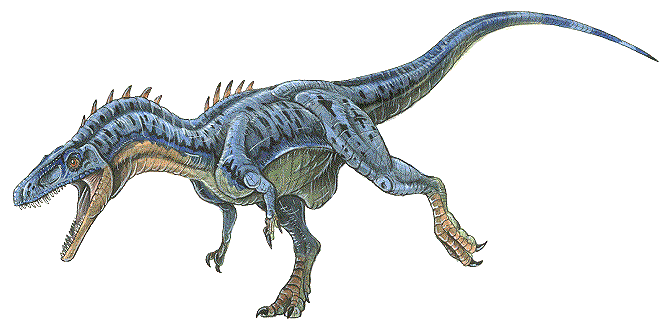|
|
 |
|
Herrerasaurus
ischigualastensis(Osvaldo A.
Reig, 1963) |
|
 |
|
Name Means: |
"Herrera's Lizard" |
Length: |
10 feet (3 m) |
|
Pronounced: |
huh-Rare-uh-Sore-us |
Weight: |
80 pounds (38 kilos) |
|
When it lived: |
Late Triassic - 225 MYA |
|
|
|
Where found: |
San Juan Province, northwestern
Argentina |
|
|
|
Herrerasaurus is one of the oldest dinosaurs ever found. It is
close to 230 million years old! It is one of three dinosaurs found in
South America that represent the earliest form of meat-eating
dinosaurs. In fact, Herrerasaurus may be the oldest of the
three. It was a fast, ferocious hunter and it set the stage for large
predatory dinosaurs to become the most dominant animals on earth for
more than 150 million years.
Unlike later dinosaurs, Herrerasaurus had a wide variety of
non-dinosaur creatures from which to chose for its menu. In the
Triassic there were many types of creatures still roaming the land
that would later disappear in an extinction event at the end of the
Triassic, which the dinosaurs survived. One of the main types of
creatures upon which Herrerasaurus would have fed were the
mammal-like reptiles. For many millions of years the mammal-like
reptiles were the dominant land creatures until dinosaurs appeared on
the scene. They were slower and less adaptable than the dinosaurs and
could not survive the competition. Herrerasaurus would have
also eaten lizards, amphibians and possibly some of the large insects
that lived in the Triassic.
Herrerasaurus, being an early dinosaur, seems to have had
some characteristics that confuse scientists trying to find its place
in dinosaur evolution. It shows traits that show up in much later
Jurassic dinosaurs and traits that are found in different
classifications of dinosaurs, making it difficult to fit it into a
specific family tree. Its teeth are more conical in shape than later
or contemporary dinosaurs, and they have serrations like most of the
later carnivorous dinosaurs. It also appears that the Herrerasaurus
jaw was somewhat flexible in order to fit more firmly around its prey
and prevent it from escaping. Its arms show proportions more similar
to later predatory dinosaurs in that they were much shorter than its
hind limbs and clearly designed for prey capture. It is estimated that Herrerasaurus could have reached
lengths of up to 15 feet (4.5 m), making it as large as dinosaurs that
did not come along until well into the Jurassic.
Herrerasaurid anatomy is unusual and
specialized, and they are not considered to be ancestral to any later
dinosaur group. They often present a mixture of very primitive and
derived traits. The
acetabulum is only partly open, and there are only two
sacral vertebrae, the lowest number among dinosaurs. The pubic
bone has a derived structure, being rotated somewhat posteriorly and
folded to create a superficially
tetanuran-like terminal expansion, especially prominent in H.
ischigulastensis. The hand is primitive in having five metacarpals
and the third finger longer than the second, but
theropod-like in having only three long fingers, with curved
claws. Herrerasaurids also have a hinged mandible like theropods, but
this may have evolved independently.
Found in the Late
Triassic of the
Ischigualasto Formation of northwestern Argentina,
Herrerasaurus ischigualastensis is an early
archosaur and on the verge of being a dinosaur proper. The first
specimen was found in 1958 by Victorino Herrera, for whom the fossil
was named. This skeleton was incomplete, but the discovery of a
complete skull in 1988 and additional fragments have provided enough
information to make a complete reconstruction; this has also permitted
Paul Sereno at the University of Chicago to redescribe
Herrerasaurus properly in a series of papers published in the
Journal of Vertebrate Paleontology. Material found thus far suggests
that it was a large carnivore about three to four meters long.
Also in the Middle to Late Triassic of
South America, other dinosaur relatives have been found which may be
closely related to Herrerasaurus. These include the
incompletely known Staurikosaurus pricei from southern Brazil
and northwestern Argentina and Ischisaurus cattoi, which is
very similar to Herrerasaurus and may even be the same species.
The North American Chindesaurus briansmalli, from the Chinle
Formation, may also be related.
Systematic relationships of
Herrerasaurus and its relatives are far from certain. While some
analyses suggest they are sister to the dinosaurs, others consider
them saurischian or even theropods. The importance of this group is
that they give us some idea of the time at which dinosaurs evolved
(towards the end of the Triassic) and what the earliest dinosaurs
would have looked like. |
| |
| |
|
|
|
|
|
|
|
|
Edugraphics.Net | Feenixx Publishing |
|
|
|
|
|

